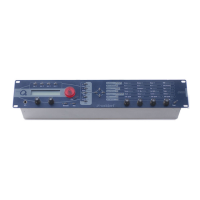Sound Parameters – Effects
87 Waldorf microQ User´s Manual
The assignment of the second effect processor is done with the FX2 (glb) link parameter in the
Global Menu. Please also see the chapter “Global Menu” on page 130.
On the following pages all effect types will be described, together with their available setttings.
Bypass
Disables the effect unit. No further parameters available.
Chorus
A Chorus effect is generated by using Comb filters that generate slightly detuned copies of the input
signal and mix it into the output signal. The result sounds like an ensemble of several simultaneous
sounds, like a choir as opposed to a single voice; hence the name Chorus. The detuning is generated
by an internal LFO that can be controlled in speed and depth. The Chorus’ high frequency output can
be dampened with the Cutoff parameter.
A Mix setting of 48 to 96 produces the strongest effect because both the unaffected signal and
the processed signal are mixed together.
Speed | Depth
064 | 064
Speed 0…127
Sets the LFO speed of the Chorus effect.
Depth 0…127
Sets the modulation depth of the Chorus effect.
Delay
064
Delay 0…127
Sets the initial delay that is added to the Chorus delay line.
Flanger
The Flanger effect is very similar to the Chorus effect, but features feedback circuitry to feed the
generated signal back into the comb filter. This generates a deeper detuning and colorizes the signal.
With extreme settings you can hear a whistling sound which is very characteristic of a Flanger effect.
A Mix setting of 48 to 96 produces the strongest effect because both the unaffected signal and
the processed signal are mixed together.
Speed | Depth
064 | 064
Speed 0…127
Sets the LFO speed of the Flanger effect.

